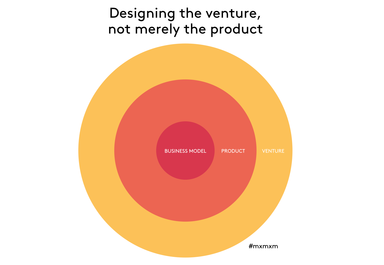We recently celebrated our 7th anniversary, a moment that traditionally provides an opportunity to totally freak out about how much has happened, and what has changed and continues to change. In this post, I wanted to share one of the most exciting changes we’re making here at Made by Many with a wider audience – not least because it addresses a problem that I believe anyone trying to create sustainable value through digital products will recognise.
Here’s the problem: the digital things many of us are now designing, making, launching, scaling and operating for our businesses and for clients now live for a long time. In fact, some of them just carry on living, emerging and evolving indefinitely. We have products in market that are 6 years old.
We don't just deliver a product and walk away. It needs to adapt and grow. We create new models, new channels and categories. We have to be able to help clients absorb these into their businesses and organisational structures.
This is very different to the ‘limited shelf-life’ mentality of a few years ago. I remember when we launched Art of the Trench for Burberry in November 2009 we had lots of arguments with the client, who believed it was a campaign that “would be over by Christmas”. And yet Art of the Trench still lives in several forms: a Tumblr version of the original concept, and as a flagship homepage experience on the main ecommerce site, where people can browse images of beautiful people wearing beautiful coats AND THEN BUY THEM (something I seem to remember was considered 'vulgar' in 2009/10).
Arguably, Art of the Trench is as close to a ‘campaign’ as anything we would ever want to do at Made by Many. Nevertheless, it still lives – approaching five years since we launched the first release! If that’s true even of a campaign idea, it is especially true where we are making a product that requires a support infrastructure that doesn’t exist within the client’s current set of capabilities. And this begs some awkward questions:
- When and how do you hand it back to the client?
- What sort of operational team does a client need to support a product for years?
- Where does that team come from?
- How do you keep innovating, continuously, and moving the product forward?
- How do you budget, plan for and help the wider business appreciate its value/potential?
At Made by Many we’ve spent a long time working out how to create very capable cross-functional product teams. These teams carry out innovation at the business model level across the whole product stack through insights, design and technology. But very few clients have a spare product innovation team hanging around waiting for something new to look after.
From day one, our mission has always been to help clients innovate and take new products to market, with a view to writing ourselves out of the story and handing everything back to them. There’s a strategic business reason for this:
our model is about product innovation, not managing operations indefinitely. If we looked after all the things we make for clients on an ongoing basis it would drag us away from making new stuff. Maybe two thirds of the business would now be supporting sites – which they would hate by the way. It would inevitably drag us away from the innovation mission.
Managing people’s websites for them like that feels like it belongs to the old days – it’s something that digital agency 1.0 does, and it stinks of ‘lock-in’ and incentivises everyone to behave badly and slows you down.
So, what do you do? Because sometimes a client literally can’t support what you’ve built for them. The last thing you want to do is to make awesome new products and services for people, and then hand over the keys and walk away. Those products won’t last and you will not have created any lasting value. But equally, you can’t afford to get sucked into a long-term support role.
Here’s what we’re doing about it. In a nutshell, we’re experimenting with a new model on two live projects that involve us recruiting, training and incubating a team around a product we’re making – with a view to implanting the whole venture back into the mother-org when it’s capable of supporting the product. We’ve realized that it’s about designing the whole venture, and not merely the product.
We’re pretty excited about it, but as ever with us it’s a hypothesis and we’re learning. We do know that this is a big problem for nearly everyone in a world where brands will increasingly be managing and developing their own digital products over the long term. It’s such a cliché to say these things are never finished – but it’s true and it speaks to a very considerable, very real challenge.
I’ll let you know how it goes! And if anyone knows what we should call this thing I’d love to hear from you. We’ve been referring to it internally – with our tongues firmly in our cheeks – as ‘Made by Made by Many’ and ‘MxMxM’, but we won’t be calling it either of these things – and nor will we be calling it an ‘In-cellerator’. If you have great ideas please tweet us with the hashtag #mxmxm.



